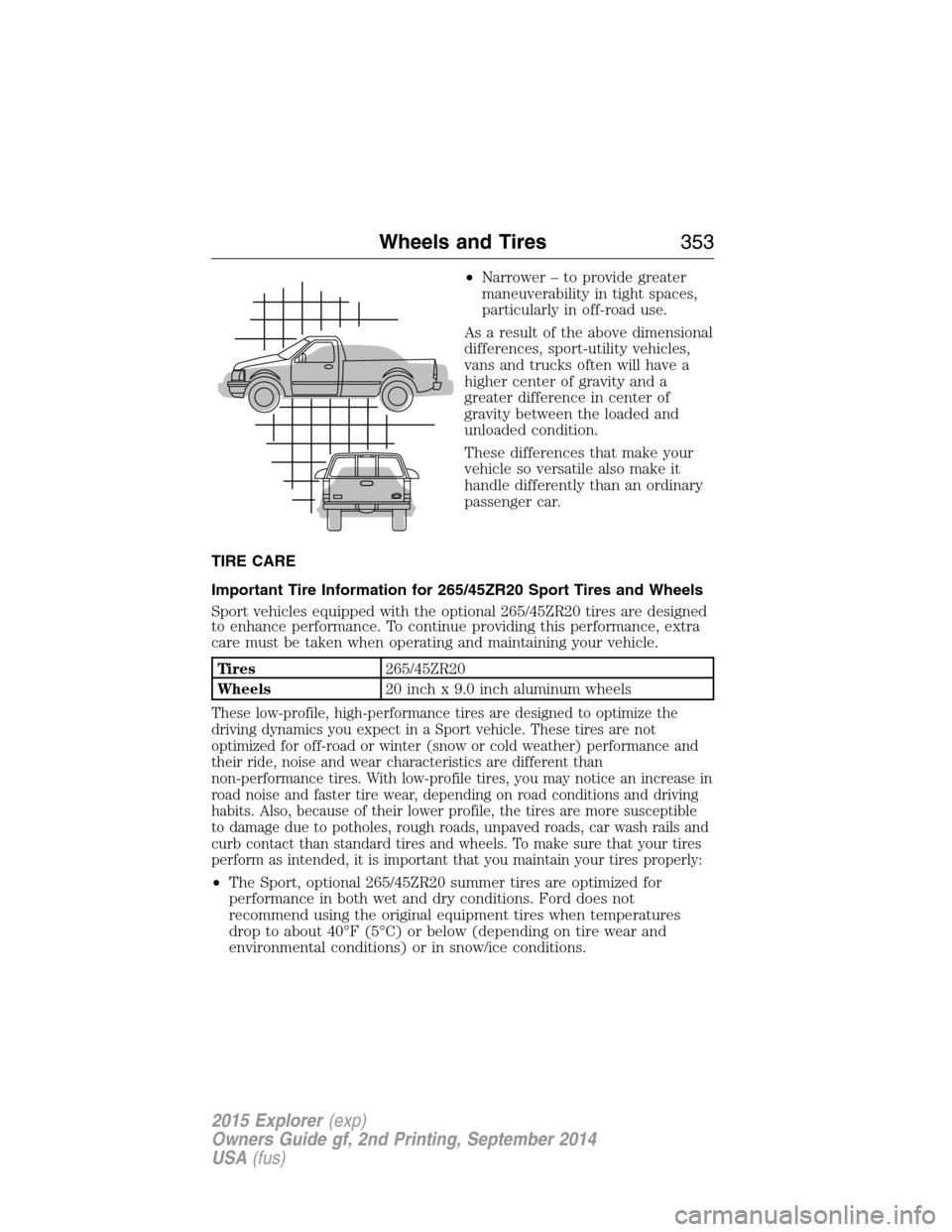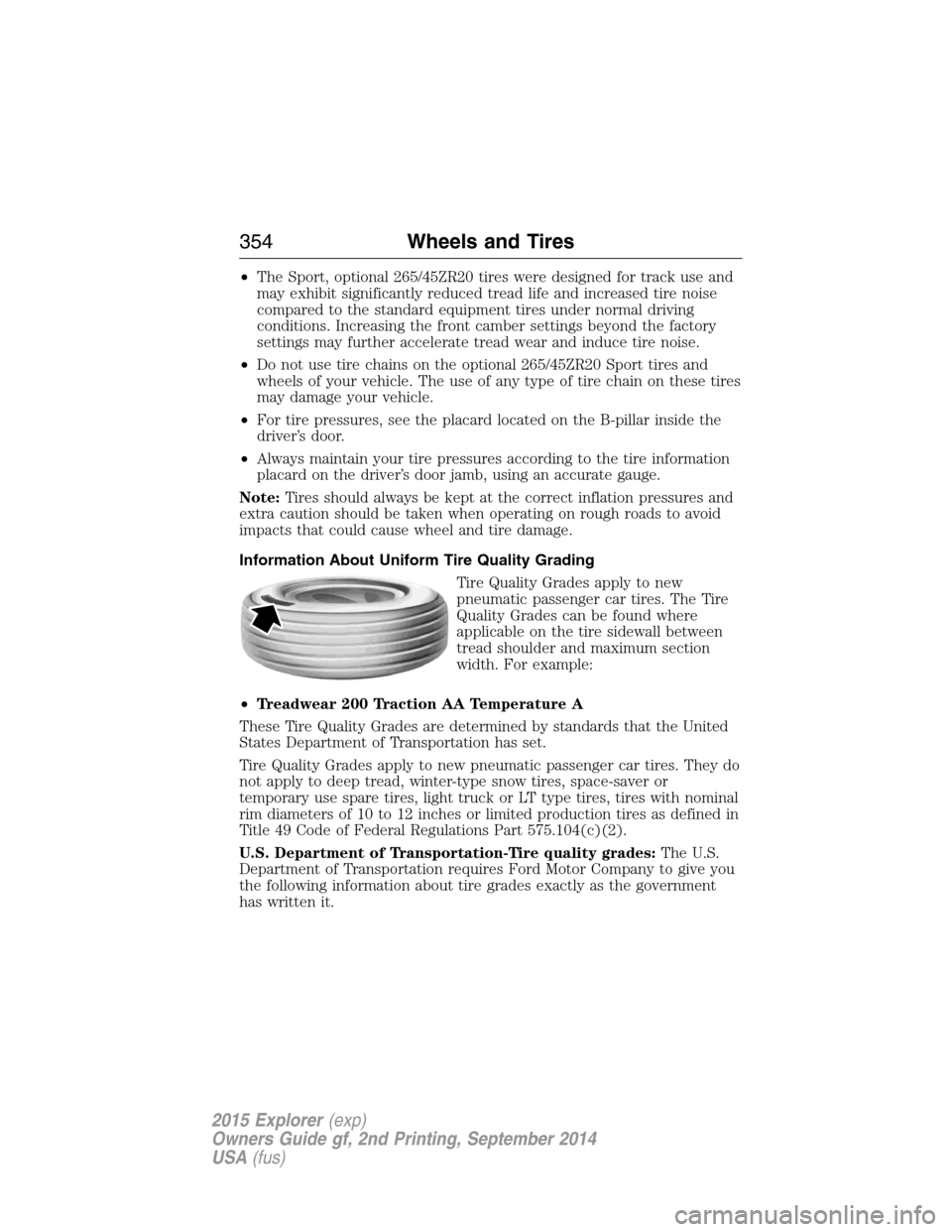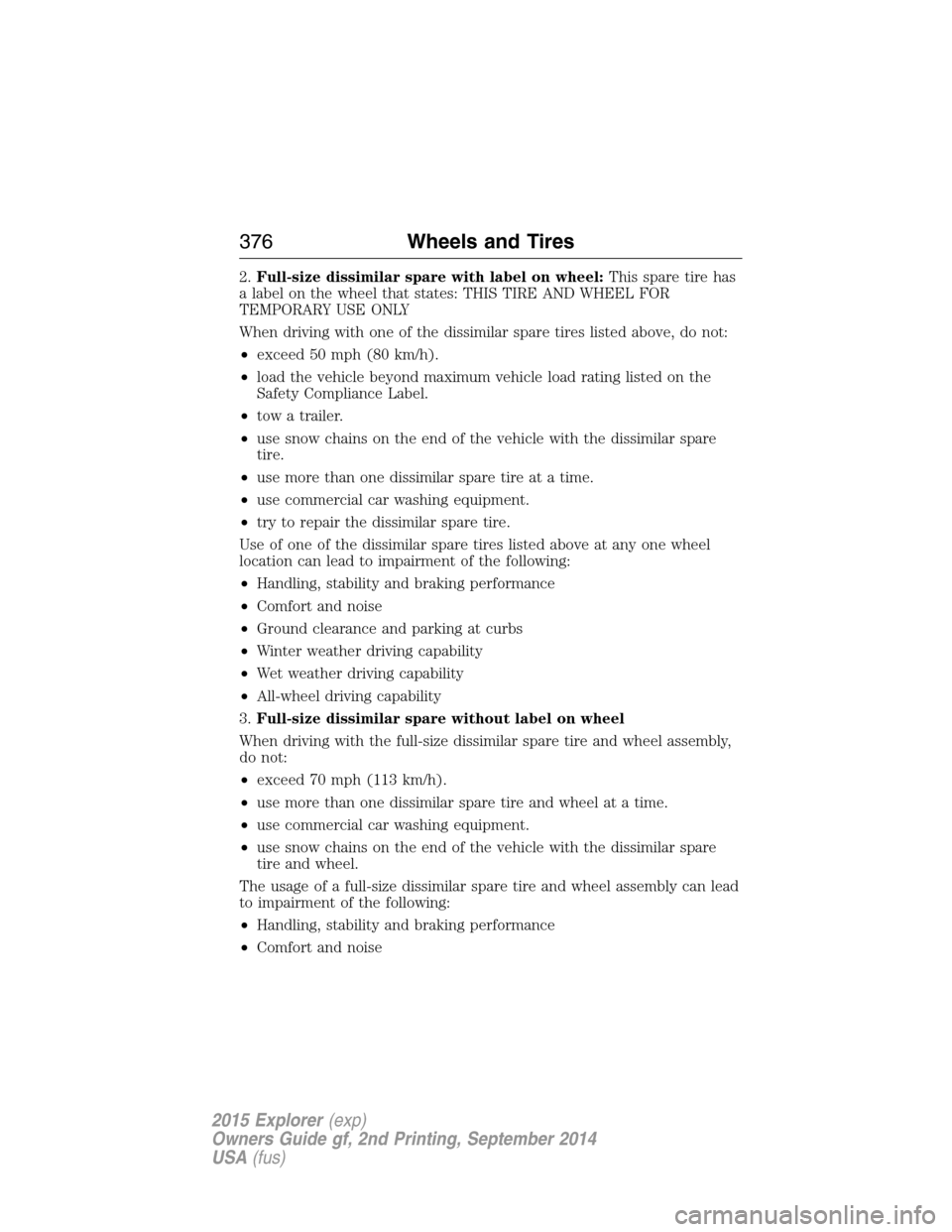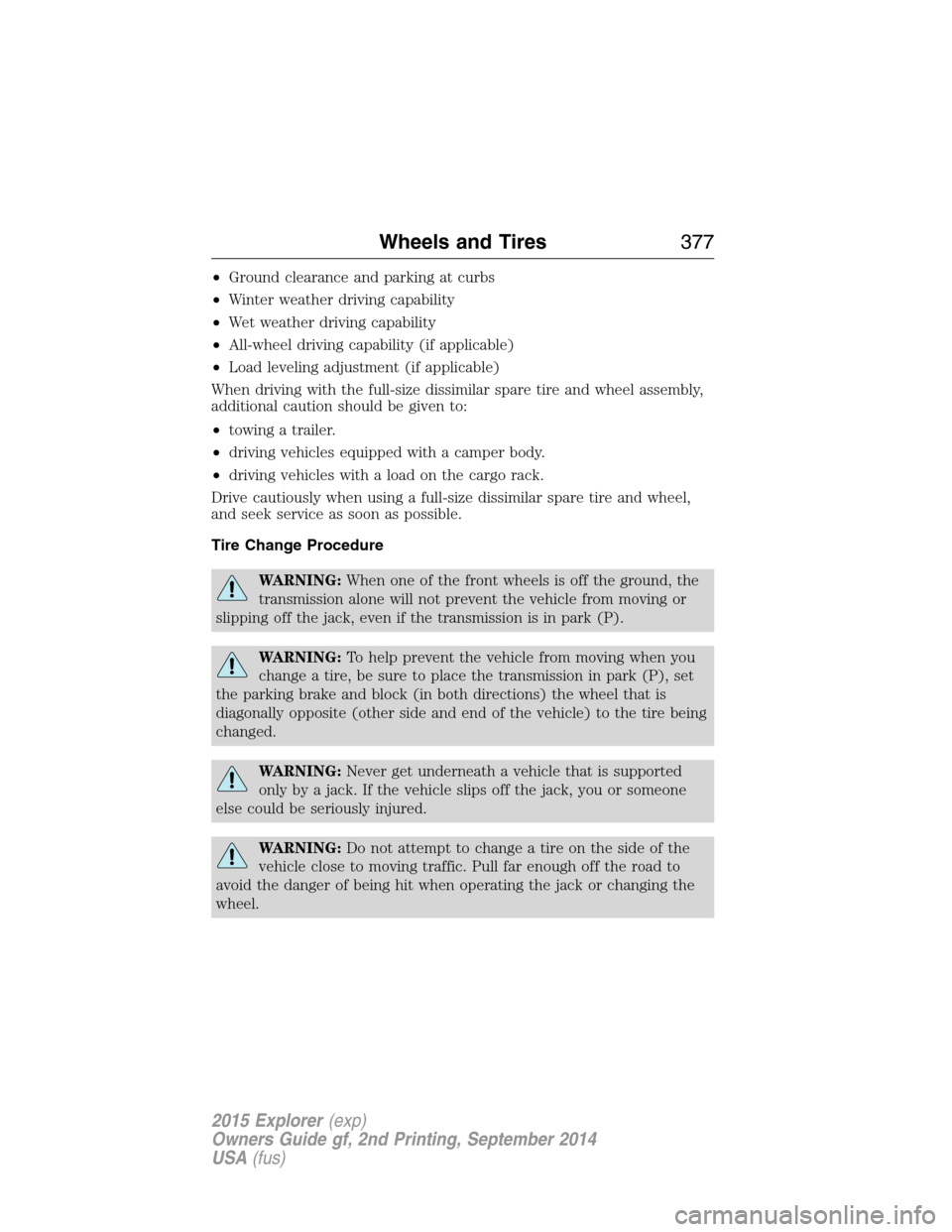Page 354 of 596

•Narrower – to provide greater
maneuverability in tight spaces,
particularly in off-road use.
As a result of the above dimensional
differences, sport-utility vehicles,
vans and trucks often will have a
higher center of gravity and a
greater difference in center of
gravity between the loaded and
unloaded condition.
These differences that make your
vehicle so versatile also make it
handle differently than an ordinary
passenger car.
TIRE CARE
Important Tire Information for 265/45ZR20 Sport Tires and Wheels
Sport vehicles equipped with the optional 265/45ZR20 tires are designed
to enhance performance. To continue providing this performance, extra
care must be taken when operating and maintaining your vehicle.
Tires265/45ZR20
Wheels20 inch x 9.0 inch aluminum wheels
These low-profile, high-performance tires are designed to optimize the
driving dynamics you expect in a Sport vehicle. These tires are not
optimized for off-road or winter (snow or cold weather) performance and
their ride, noise and wear characteristics are different than
non-performance tires. With low-profile tires, you may notice an increase in
road noise and faster tire wear, depending on road conditions and driving
habits. Also, because of their lower profile, the tires are more susceptible
to damage due to potholes, rough roads, unpaved roads, car wash rails and
curb contact than standard tires and wheels. To make sure that your tires
perform as intended, it is important that you maintain your tires properly:
•The Sport, optional 265/45ZR20 summer tires are optimized for
performance in both wet and dry conditions. Ford does not
recommend using the original equipment tires when temperatures
drop to about 40°F (5°C) or below (depending on tire wear and
environmental conditions) or in snow/ice conditions.
Wheels and Tires353
2015 Explorer(exp)
Owners Guide gf, 2nd Printing, September 2014
USA(fus)
Page 355 of 596

•The Sport, optional 265/45ZR20 tires were designed for track use and
may exhibit significantly reduced tread life and increased tire noise
compared to the standard equipment tires under normal driving
conditions. Increasing the front camber settings beyond the factory
settings may further accelerate tread wear and induce tire noise.
•Do not use tire chains on the optional 265/45ZR20 Sport tires and
wheels of your vehicle. The use of any type of tire chain on these tires
may damage your vehicle.
•For tire pressures, see the placard located on the B-pillar inside the
driver’s door.
•Always maintain your tire pressures according to the tire information
placard on the driver’s door jamb, using an accurate gauge.
Note:Tires should always be kept at the correct inflation pressures and
extra caution should be taken when operating on rough roads to avoid
impacts that could cause wheel and tire damage.
Information About Uniform Tire Quality Grading
Tire Quality Grades apply to new
pneumatic passenger car tires. The Tire
Quality Grades can be found where
applicable on the tire sidewall between
tread shoulder and maximum section
width. For example:
•Treadwear 200 Traction AA Temperature A
These Tire Quality Grades are determined by standards that the United
States Department of Transportation has set.
Tire Quality Grades apply to new pneumatic passenger car tires. They do
not apply to deep tread, winter-type snow tires, space-saver or
temporary use spare tires, light truck or LT type tires, tires with nominal
rim diameters of 10 to 12 inches or limited production tires as defined in
Title 49 Code of Federal Regulations Part 575.104(c)(2).
U.S. Department of Transportation-Tire quality grades:The U.S.
Department of Transportation requires Ford Motor Company to give you
the following information about tire grades exactly as the government
has written it.
354Wheels and Tires
2015 Explorer(exp)
Owners Guide gf, 2nd Printing, September 2014
USA(fus)
Page 377 of 596

2.Full-size dissimilar spare with label on wheel:This spare tire has
a label on the wheel that states: THIS TIRE AND WHEEL FOR
TEMPORARY USE ONLY
When driving with one of the dissimilar spare tires listed above, do not:
•exceed 50 mph (80 km/h).
•load the vehicle beyond maximum vehicle load rating listed on the
Safety Compliance Label.
•tow a trailer.
•use snow chains on the end of the vehicle with the dissimilar spare
tire.
•use more than one dissimilar spare tire at a time.
•use commercial car washing equipment.
•try to repair the dissimilar spare tire.
Use of one of the dissimilar spare tires listed above at any one wheel
location can lead to impairment of the following:
•Handling, stability and braking performance
•Comfort and noise
•Ground clearance and parking at curbs
•Winter weather driving capability
•Wet weather driving capability
•All-wheel driving capability
3.Full-size dissimilar spare without label on wheel
When driving with the full-size dissimilar spare tire and wheel assembly,
do not:
•exceed 70 mph (113 km/h).
•use more than one dissimilar spare tire and wheel at a time.
•use commercial car washing equipment.
•use snow chains on the end of the vehicle with the dissimilar spare
tire and wheel.
The usage of a full-size dissimilar spare tire and wheel assembly can lead
to impairment of the following:
•Handling, stability and braking performance
•Comfort and noise
376Wheels and Tires
2015 Explorer(exp)
Owners Guide gf, 2nd Printing, September 2014
USA(fus)
Page 378 of 596

•Ground clearance and parking at curbs
•Winter weather driving capability
•Wet weather driving capability
•All-wheel driving capability (if applicable)
•Load leveling adjustment (if applicable)
When driving with the full-size dissimilar spare tire and wheel assembly,
additional caution should be given to:
•towing a trailer.
•driving vehicles equipped with a camper body.
•driving vehicles with a load on the cargo rack.
Drive cautiously when using a full-size dissimilar spare tire and wheel,
and seek service as soon as possible.
Tire Change Procedure
WARNING:When one of the front wheels is off the ground, the
transmission alone will not prevent the vehicle from moving or
slipping off the jack, even if the transmission is in park (P).
WARNING:To help prevent the vehicle from moving when you
change a tire, be sure to place the transmission in park (P), set
the parking brake and block (in both directions) the wheel that is
diagonally opposite (other side and end of the vehicle) to the tire being
changed.
WARNING:Never get underneath a vehicle that is supported
only by a jack. If the vehicle slips off the jack, you or someone
else could be seriously injured.
WARNING:Do not attempt to change a tire on the side of the
vehicle close to moving traffic. Pull far enough off the road to
avoid the danger of being hit when operating the jack or changing the
wheel.
Wheels and Tires377
2015 Explorer(exp)
Owners Guide gf, 2nd Printing, September 2014
USA(fus)